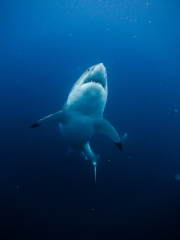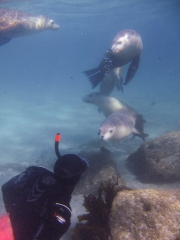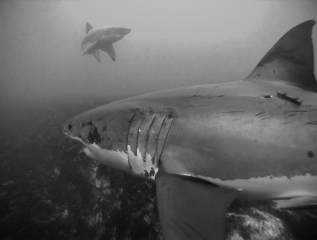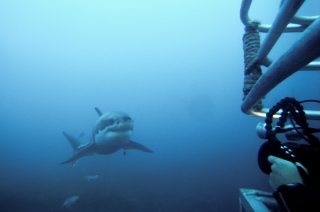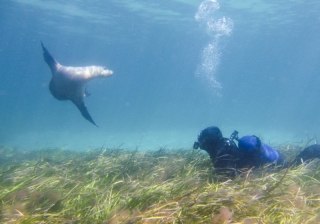After a great ending of 2012 with cave exploration on Grand Bahama I braced myself and went on a long journey. From the Caribbean, across USA and then across the Pacific Ocean took me all the way to Australia, stumbling out of the plane, trying to figure out what time of what day it was. From caves where the fish life was somewhat limited I was now to set out on a completely different type of diving again, this time with some of the largest fishes around, great white sharks. I made my way down to South Australia and Rodney Fox shark expeditions. This operation has been around for a long time and the experience of the crew is hard to match. Rodney, who started the operation is the survivor of a very serious shark attack but instead of being afraid of his attacker he has spent most of his life studying them and helping others to get the opportunity to meet this awesome animal.Today his son Andrew runs the expeditions instead and his love and knowledge of the sharks is impressive.
Aboard The Princess II I took the place as one of the volunteers that helps out onboard with whatever needed doing together with the rest of the friendly crew. Once again I was exposed to a whole new part of diving that I had never experienced before. In a few days I went from precision buoyancy, loaded with gear in the back of a cave to being loaded down with lead to be stable on the bottom of a cage. One of the unique things about the sharkdiving with Rodney Fox is the ability to lower a cage with four divers to the seafloor with a crane. First seeing the behavior of the sharks at the surface where they are attracted to and attacking the bait and then seeing them at the bottom swimming along the formations there is two quite different experiences. Together they give a better impression of the sharks in my opinion and it can only be experienced here. Its hard to explain just how big of a fish the great whites are. Sure, there are a lot of big sharks out there but these are not only 4-5 meters long, they are massive muscular animals that leaves no doubt as to who is in charge. When one of them gives the cage a little investigative nudge, you will notice. These are truly the rulers of the sea around here and you are just a visitor in their realm.
Around the Neptune islands there are sharks pretty much year round and they are attracted to the colony of New Zealand fur seals that live here. The shark expeditions has a scientific side to them as well and all the sharks are well documented with photo identification, in large part carried out by Andrew himself. He could fast and reliably name most of the sharks we encountered and counted up to twenty separate individuals around the boat in one single day.
Another part is collecting tissue samples from the sharks which is not for the faint of heart. Just watching Andrew leaning out of the cage with a speargun and firing at a shark that was about the same size of the cage itself was an interesting feeling but thankfully the shark seemed to notice it about as much as a mosquito bite. The job these guys do to raise the awareness of the sharks and giving everyone the opportunity to get out and meet these animals face to face is important I think and after seeing how much care is taken to do it in a responsible way that doesn’t hurt the sharks I have been able to create my own opinion on the baited cage diving and how it can be run in a responsible way.
So where I am off to next you will soon find out, I can tell you it will include some pretty low water temperatures and a fair bit of excitement. Stay tuned and dive safe!
